The Monastery of St Moses, Syria: Introduction
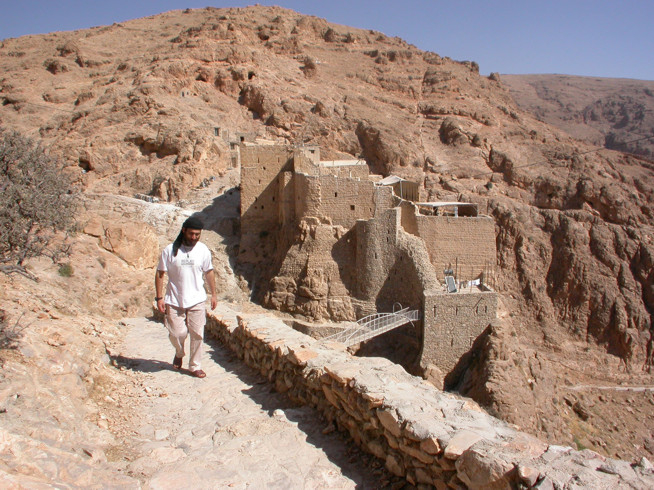
Deir Mar Musa, or the Monastery of St. Moses, can be found about 90 km north of Damascus in the desert Qalamoun Mountains, isolated between the road from Damascus to Homs/Hama/Aleppo and the road from Damascus to Palmyra-Tadmor. The nearest town is al-Nabk, or Nebek, 10.4 miles or 6.5 km to the West. Deir Mar Musa's recent history begins with an expedition to the abandoned site by the American University of Beirut in May 1981. Canadian scholar Erica Dodd was a part of that team, and undertook a study of the mediaeval frescoes in the chapel. In Dodd's words "Our visit attracted the interest of the Syrian Catholic priest of the Church of the Virgin in Nebek who sent an enthusiastic, armed posse from Nebek to dispossess the intruders. The armed men arrived at the door of the monastery and fastened a tight lock on it, politely asking us to leave at once." This was despite the presence of an official from the Syrian Department of Antiquities who had accompanied the team. Dodd published a report on the expedition in 1982 and a longer article in 1992, eventually returning to the site in 1993.
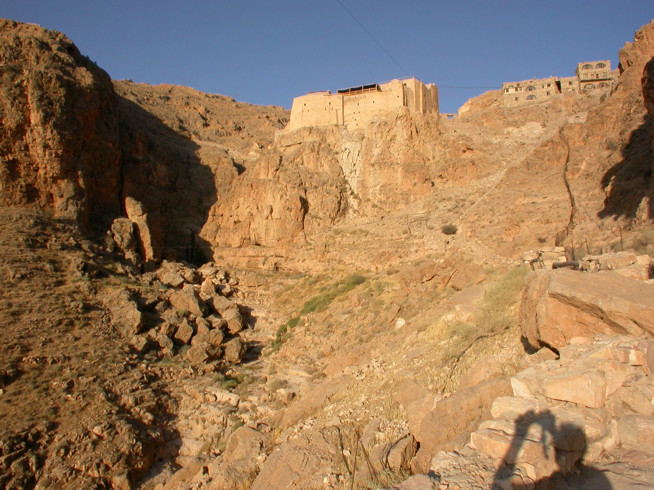
View of Deir Mar Musa in 2004 from the main approach in the East, with the old buildings at the centre, and to the right the new buildings created using traditional materials and techniques. The men of the al-Khalil order sleep in the new buildings, the women sleep in the old buildings.
Dodd was in for a surprise, however, when she returned in 1993. Deir Mar Musa was by then fully occupied again, with a monastic community led by Italian Jesuit Father Paolo Dall'Oglio. Fr. Paolo, or "Abouna" Paolo in Arabic, had been studying Arabic since 1977 in Damascus, Beirut, and elsewhere, and heard of the 1982 expedition. He came to the site, immediately recognising its importance and potential. He obtained the support of Syria's Department of Antiquities, who built a roof for the chapel, but in particular it was the volunteers he brought from all over Syria, and also from Iraq and even Italy, that had rebuilt a community, sensitively restoring the buildings and creating new ones based on the traditional stone-built architecture of the region. Abouna Paolo had persuaded the Istituto del Restauro in Rome to send conservators to conserve the frescoes, who combined this work with training a new generation of young Syrian conservators. During the restoration work objects were found from the earlier occupation and are stored at the monastery in a small museum, including coins, glass, wood, wax candles, metal, but above all, pottery. Goats, sheep and chickens were acquired to support the community, and they make a very nice cheese.
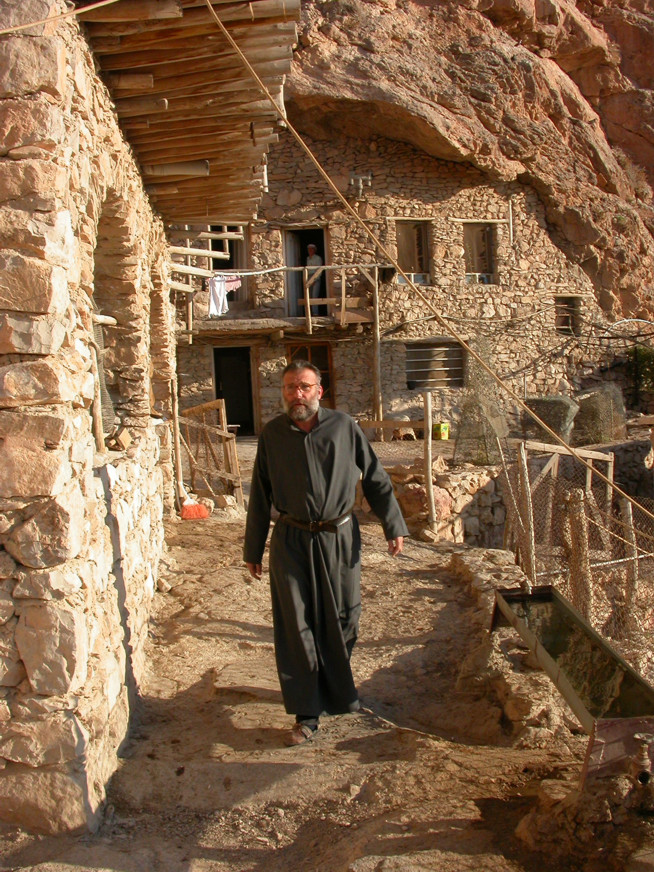
Father Paolo Dall'Oglio in the new buildings in 2004, behind him is a large cave that may actually have been the original focus of the complex.
In 1989, Abouna Paolo obtained a PhD degree from the Pontifical Gregorian University, his doctoral dissertation was on the topic "About Hope in Islam". Abouna Paolo always considered interfaith dialogue to be one of the principal objectives of the monastery, and in 1992 when he established the monastic order at Deir Mar Musa he named it al-Khalil. Al-Khalil is a reference to the Qur'anic epithet for Abraham, Khalil al-Rahman, or "Friend of the Merciful (God)" and is a direct link to the prophet seen as the founder of Judaism, Christianity, and Islam. It was this work that was taking up much of his energies after the work of rebuilding the monastery had been established.
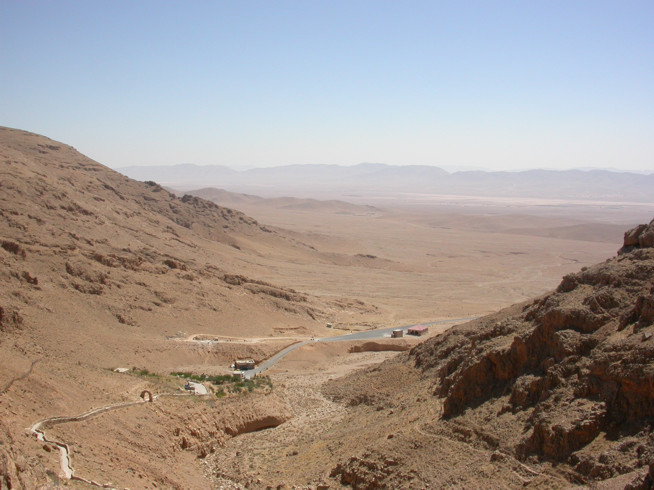
The view in 2004 from the monastery to the East, across the Syrian desert.
In 2002 I was working on another site in Syria, Tell al-Acharneh, and at the end of the season did some travelling around Syria to look at other archaeological sites. A colleague of mine at the British Museum had suggested that I visit his niece, Emma Loosley, who was living at the monastery of Deir Mar Musa. I had been working in Syria since 1998, mostly on excavations in Aleppo, but had successfully avoided being responsible for fieldwork myself until then. Being responsible is a lot of work that has nothing to do with archaeology, it requires extra trips to have tea at the ministry, and a lot of diplomacy. My research was on the pottery made in the Middle East between about 600 and 1800 AD, and it suited me to be able to go to different sites and study their pottery rather than get stuck on one field project. It turned out that Emma was actually an archaeologist, but one that specialised in the Byzantine period, and who was responsible for excavations at another monastery site, also part of the al-Khalil community, at al-Qaryatayn, on the road between Damascus and Palmyra.
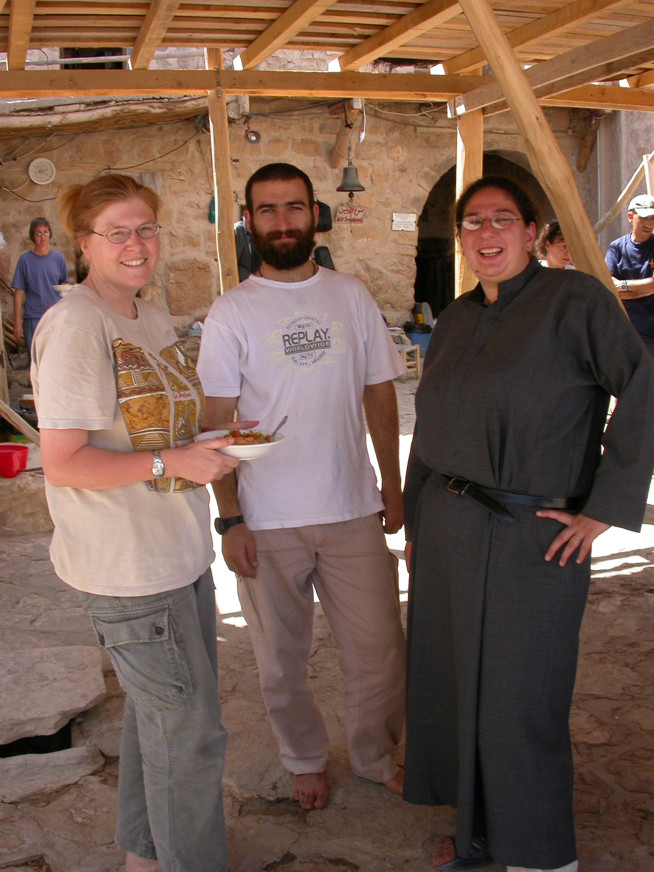
On the terrace at Deir Mar Musa in 2004: Byzantine archaeologist Emma Lossley (left) and members of the al-Khalil community, then Brother Jihad Yusuf (later Deacon and then Father), a Maronite from Wadi Nasara, and then novice (later Sister) Deema Fayyad, a member of the Greek Catholic Church from Homs . In Arabic, "jihad" really means "struggle" and is a not uncommon personal name.
As it turned out Deir Mar Musa had pottery, a very interesting group of fragments of 14th century pottery, pottery that they needed someone like me to study, and I still suspect that my colleague at the British Museum was setting me up. There was too much to study in a day trip that was to cover a number of other sites as well, so I promised to return another year. In 2004 I returned to study the pottery. That year, as I studied the pottery, Abouna Paolo persuaded me to undertake a fuller archaeological project on the monastery, as Emma was committed to al-Qaryatayn, and Mar Musa also clearly had a lot of mediaeval architecture, which is my period. He talked a lot about God's will and the Canadian connection, due to Erica Dodd. He also talked about creating a museum, one that contained archaeology, but also one that talked about the desert environment of the monastery, as they were intent on re-greening the area. I thought that this would be a good project for the ROM, a ROM in the desert so to speak, and my Natural History colleagues would join in the project to make the desert, and the world, a better place. Abouna Paolo is very persuasive. So I agreed, and started a project to do a full archaeological survey of the site and the area, and to build a museum
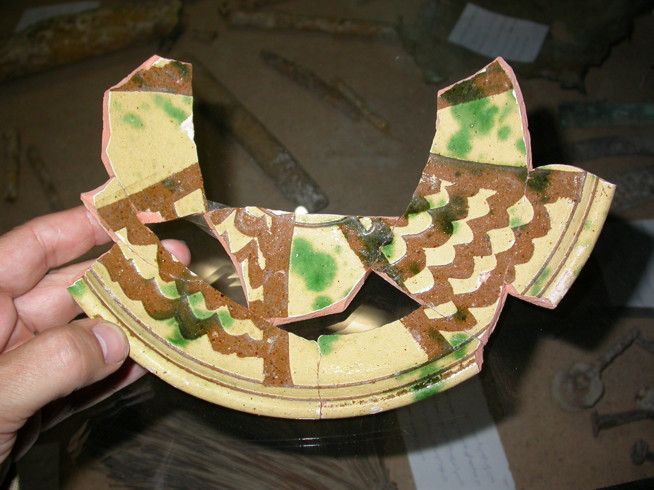
One of the fragments of pottery from the restoration work at Deir Mar Musa.
Although I hope that one day Abouna Paolo and I will both be able to return to Deir Mar Musa to continue our work, in the meantime it looks as though I will not be able to complete this work for some time. Some of my research at Deir Mar Musa has been published, some of it has not, and is too preliminary to publish anywhere other than in the informal venue of a blog. Hence this project to write a number of blogs reporting my work at Deir Mar Musa.
FURTHER READING
NAVIGATION (links will become hot as they are published)
The Monastery of St Moses, Syria: Introduction
The Monastery of St Moses, Syria: The Pottery
The Monastery of St Moses, Syria: The Frescoes
The Monastery of St Moses, Syria: The Cave Survey
The Monastery of St Moses, Syria: The Buildings
The Monastery of St Moses, Syria: The Prehistoric Remains
The Monastery of St Moses, Syria: Conclusion and Syria Today
